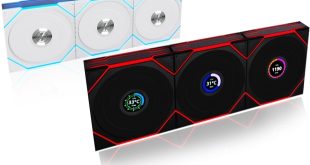MSI artwork is very distinctive, and this box highlights the ‘Military Class III' components. MSI also focus on the claim that they are the World's first to market with Thunderbolt technology.
The box is a gatefold design, opening up with an overview of the motherboard and the technologies. The lower panel is focused entirely on Thunderbolt.
The MSI bundle is extensive. There is a quick guide, software disc, software and user manual, backplate I/O, SATA cables, SLI cable, USB 3.0 panel and voltage readout (V-Check) cables.
The ATX motherboard is built on a dark PCB with blue ports and black and blue heatsinks. This is a socket LGA1155 which supports both Ivy Bridge and Sandy Bridge processors.
The motherboard has four memory slots (dual channel), which support DDR3 1066/1333/1600/1866*/2000*/2133*(OC), 2200*/2400*/2600*/2667*/2800*(OC, 22nm CPU required). Next to these slots is a power, reset and overclock button (O.C. Genie).
Underneath the 24 pin Motherboard power connector there is a V-Check point connector which is useful if you wish to monitor CPU, CPU Graphics, DDR VCC, PCH 1P05 and VCCP voltages with a digital multimeter.
The board ships with a warning sticker. If you use a 2500/2600/2700 processor then the bottom PCIe lane will be lost. MSI recommend an Ivy Bridge chip. The board has 3 x PCIe 3.0 x16 slots and 4 x PCIe 2.0 x1 slots.
Along the bottom of the board are various USB and audio headers, and the front panel connector. There is a diagnostic LED just underneath the passively cooled heatsink in this area.
Next to the ram slots are 10 LED lights. One of the LED's is the DrMos alarm system and the other LED's showcase the power phase currently being adopted by the CPU.
Another useful sticker, if you are too lazy to refer to the manual. The two white ports on the right are native SATA 6Gb/s connectors for the latest Solid State Drives.
There are a total of 8 SATA ports, the four black ports in the middle are SATA II 3 Gbps rated. The two white ports on the left are SATA III 6Gbp/s rated and linked to the ASMedia ASM1061 controller.
The front USB 3.0 header is mounted horizontally to the PCB, which is ideal to keep cable routing as tidy as possible.
Yes, you can spot the Thunderbolt connector underneath the VGA port.
Back Panel I/O Ports
- 1 x PS/2 keyboard/mouse port
- 1 x Clear CMOS button
- 1 x Coaxial S/PDIF-out port
- 1 x Optical S/PDIF-out port
- 4 x USB 2.0 ports
- 2 x USB 3.0 ports
- 1 x RJ45 LAN jack
- 1 x 6 in 1 audio jack
- 1 x HDMI® port with max. resolution up to 1920×1200 @60Hz
- 1 x DisplayPort with max. resolution up to 1920×1200 @60Hz
- 1 x VGA port with max. resolution up to 2048×1536 @75Hz
 KitGuru KitGuru.net – Tech News | Hardware News | Hardware Reviews | IOS | Mobile | Gaming | Graphics Cards
KitGuru KitGuru.net – Tech News | Hardware News | Hardware Reviews | IOS | Mobile | Gaming | Graphics Cards















Dont get it… you either want a single fan card, or a dual fan card…so just buy a single fan card, or a dual fan card- there are better dual fan coolers out there, such as XFXs Brushed Aluminium cooler, looks a thousand times better than the neon blue plastic tat on this card… Its not like your going to put this in your system and suddenly wake up one day and say- ‘i know i fancy two fans today’….
I get your point, although I think its cool you can basically change the noise/cooling balance to suit different environments. size too.
If it cost £30 more then its pretty pointless, but it seems closely priced to the other HD7770s.
Still think sapphire HD6850 was the best deal for a while at £90.
Great motherboard but im not sure on the graphics card. its clever, but for the target market im not sure its a buying decision. You either want a smaller card for a media center, or a higher cooled, size card for gaming.
Gamers wont buy the HD7770 I wouldnt think, so why not just put a larger single fan on the HD7770 in the first place and ditch the extra fan completely?
Nice idea to be creative like this, but ultimately I think its a bit pointless.
Ok, first thing first. this motherboard is from what I know the same as the GD65 but now has thunderbolt. its a great board. all we need to say (apart from the added price for thunderbolt).
The graphics card is frigging cool. The shiftable cooler idea is nice. Its maybe only useful for people who change systems regularly. so you could ditch a fan, slot it into a HPTC, then take it out, extend it then add another etc.
How many people would do that though? Might make more sense on a HD7850 or 7870. HD7770 is more suited just for media duties and low powered use.
please put two hd7770 in crossfire the results will show that they can deliver more fps
than the high end gtx 670 and hd 7870
with lots of money left over get that new motherboard
give it try